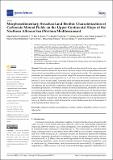Por favor, use este identificador para citar o enlazar a este item:
http://hdl.handle.net/10261/268077COMPARTIR / EXPORTAR:
 SHARE SHARE
 CORE
BASE CORE
BASE
|
|
| Visualizar otros formatos: MARC | Dublin Core | RDF | ORE | MODS | METS | DIDL | DATACITE | |

| Título: | Morphosedimentary, Structural and Benthic Characterization of Carbonate Mound Fields on the Upper Continental Slope of the Northern Alboran Sea (Western Mediterranean) |
Autor: | Sánchez-Guillamón, Olga; Rueda, José Luis; Wienberg, Claudia; Ercilla, Gemma CSIC ORCID ; Vázquez, Juan Tomás; Gomez-Ballesteros, María; Urra, Javier; Moya-Urbano, Elena; Estrada, Ferran CSIC ORCID CVN ; Hebbeln, Dierk | Palabras clave: | Carbonate mounds Geomorphology Benthos Habitats Rhodoliths Modiolus modiolus Alboran Sea |
Fecha de publicación: | feb-2022 | Editor: | Multidisciplinary Digital Publishing Institute | Citación: | Geosciences 12(3): 111 (2022) | Resumen: | Carbonate mounds clustering in three fields were characterized on the upper continental slope of the northern Alboran Sea by means of a detailed analysis of the morphosedimentary and structural features using high-resolution bathymetry and parametric profiles. The contemporary and past benthic and demersal species were studied using ROV underwater imagery and some samples. A total of 325 mounds, with heights between 1 and 18 m, and 204 buried mounds were detected between 155 to 401 m water depth. Transparent facies characterize the mounds, which root on at least six erosive surfaces, indicating different growth stages. At present, these mounds are covered with soft sediments and typical bathyal sedimentary habitat-forming species, such as sea-pens, cerianthids and sabellid polychaetes. Nevertheless, remains of colonial scleractinians, rhodoliths and bivalves were detected and their role as potential mound-forming species is discussed. We hypothesized that the formation of these mounds could be related to favorable climatic conditions for cold-water corals, possibly during the late Pleistocene. The occurrence on top of some mounds of abundant rhodoliths suggests that some mounds were in the photic zone during minimum sea level and boreal guest fauna (e.g., Modiolus modiolus), which declined in the western Mediterranean after the Termination 1a of the Last Glacial (Late Pleistocene) | Descripción: | 24 pages, 5 figures, 2 tables, 1 appendix.-- Data Availability Statement: Datasets are stored in the database of the Instituto Español de Oceanografía (IEO) for the MONCARAL and RIGEL projects, some of which is available at the IEO marine geospatial information viewers and services: http://www.ieo.es/en/ideo (accessed on 15 December 2021) | Versión del editor: | https://doi.org/10.3390/geosciences12030111 | URI: | http://hdl.handle.net/10261/268077 | DOI: | 10.3390/geosciences12030111 | E-ISSN: | 2076-3263 |
| Aparece en las colecciones: | (ICM) Artículos (IEO) Artículos |
Ficheros en este ítem:
| Fichero | Descripción | Tamaño | Formato | |
|---|---|---|---|---|
| Sanchez_Guillamon_et_al_2022.pdf | 6,23 MB | Adobe PDF |  Visualizar/Abrir |
CORE Recommender
SCOPUSTM
Citations
7
checked on 20-abr-2024
WEB OF SCIENCETM
Citations
6
checked on 29-feb-2024
Page view(s)
54
checked on 27-abr-2024
Download(s)
52
checked on 27-abr-2024
Google ScholarTM
Check
Altmetric
Altmetric
Este item está licenciado bajo una Licencia Creative Commons

